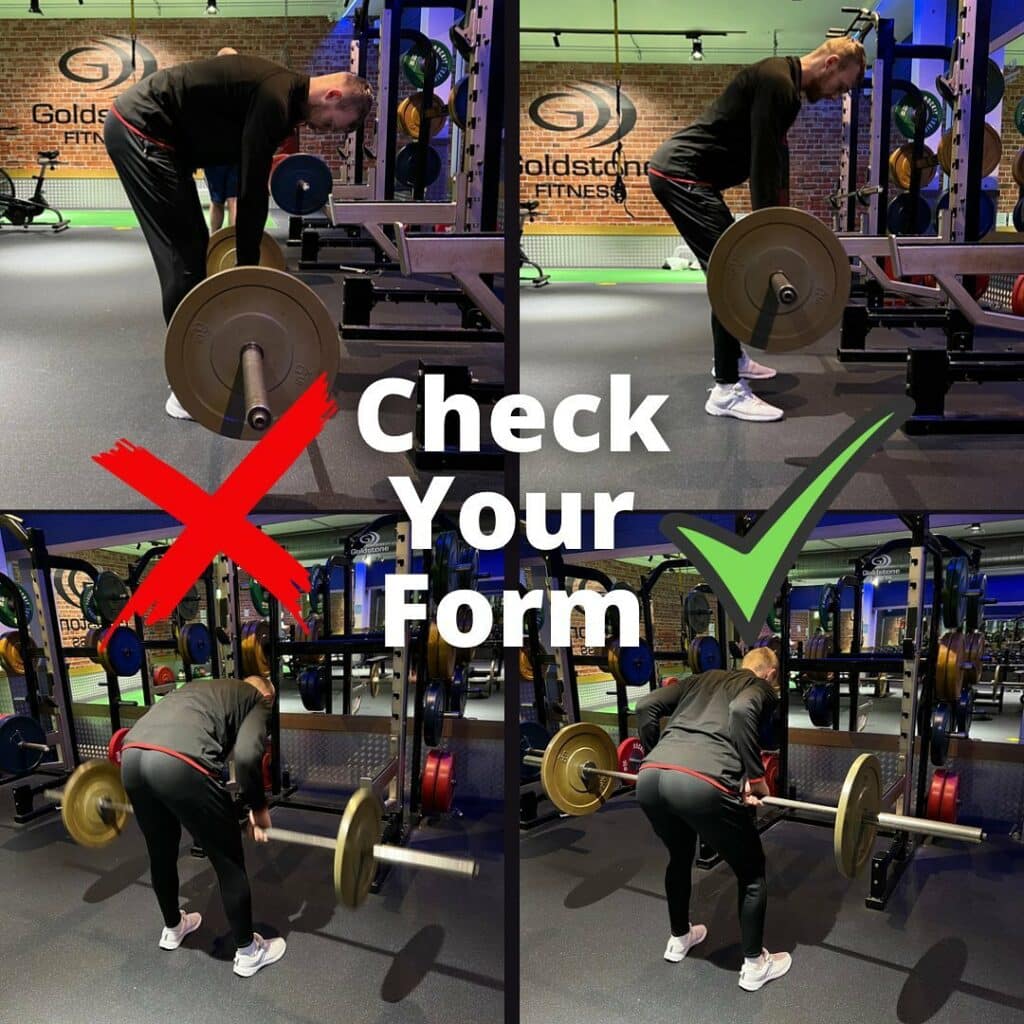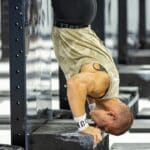The barbell row is a compound exercise that works multiple muscles in your back at the same time, making it a great movement for back growth! There are two main grip variations, overhand or underhand barbell row, and which variation you use will depend greatly on what your goals are. Here we will look at the underhand vs. overhand row argument in more detail.
So, should you be doing your barbell row overhand or underhand? An overhand grip will work more of your upper back muscles, including your rhomboids and traps. Whereas the underhand grip will focus more on working your lats. Your goals may be sport-related, or specific muscle growth, but knowing which grip to use will help you reach your goals.
The barbell row is unique from many other back focused lifting exercises in that it will work to strengthen your spinal erectors. This is the group of muscles that extend vertically up the length of your back and keep your spine in position.
A bent-over row is often seen being performed with a straight barbell and can either be performed with an empty bar or with added weight.
Jump to:
- Overhand Grip or Underhand Grip?
- How to Perform Underhand Barbell Rows and Overhand Barbell Rows Correctly
- How to perform a standard barbell row?
- Grip variations
- Common Mistakes & Misunderstandings
- Don’t keep your legs straight
- Not bending over
- Not keeping your neck and spine neutral
- Not keeping your chest up
- Not engaging your core
- Not retracting your scapula or shoulder blades
- Believing barbell row is dangerous
- A bad hands positioning
- Maximizing Muscle Growth to Back Muscles
Overhand Grip or Underhand Grip?

@luka.dubai
As previously mentioned your bent-over row grip choice will target different muscles. Let’s look at the difference in more detail.
Types of Grip for Rows
- OVERHAND Grip – Hold the bar with your palms facing toward your body. Your grip will typically be shoulder width with elbows at a 15-45 degree angle.
- UNDERHAND Grip, also known as the Reverse Grip – Hold the bar with your palms facing away from your body, hands slightly narrower than shoulder width, and elbows close to your torso.
- Narrow Grip – Position your hands on the bar just outside your hips.
- Wide Grip – Position your hands on the bar just wider than hip-width.
- Neutral Grip – Palms face each other, mostly used for dumbbell rows.
Types of Barbell Row
- Underhand, or Reverse-grip bent-over row – Typically a more comfortable grip, with elbows close to your body which allows you to go heavier with the weight. Targets the lats, lower traps, and biceps more.
- Overhand grip bent-over row – Requires more grip strength which may limit your weight as your grip will wear out as you get heavier. Elbows at a 15-45 degree angle, requiring more work from forearm extensors. Great for building grip strength and forearm extensors. Targets upper back muscles, including the posterior deltoid, upper traps, and rhomboids.
- Wide grip bent-over row – Performed with an overhand grip. Requires more demand from the core to stabilize the movement. Heavily focuses on the upper back and core and it is great for growing a wide upper back.
- Narrow grip – Performed either with an underhand or overhand grip. Easier grip on the bar which allows you to load more weight. More on elbow flexion and shoulder adduction. Targets lats and biceps.
How to Perform Underhand Barbell Rows and Overhand Barbell Rows Correctly
The underhand vs overhand rows argument is irrelevant if you don’t know how to set up your row correctly. Correct form is the most important aspect for getting maximum gains. In this section, we will go through how to perform barbell rows correctly.
How to perform a standard barbell row?
Start with feet hip-width apart, in a neutral position, create a solid base and then deadlift the bar up. Now that the bar is in the correct starting position, keeping a neutral spine, push your hips backward and have a slight bend in the knee.
Lower the bar down, stopping at the point where the flexibility of your hamstrings prevents you from going further and ensuring there is no round of the back. For most, this will be somewhere between a 15 and 45-degree angle.
Take a firm grip and imagine you are trying to break the bar in half to lock your shoulders into place. Keeping your core tight, row the weight upwards, driving your elbows up and backward, stopping the bar at your torso.
For correct muscle activation, think about squeezing your shoulder blades together and keeping your hips, back, and head aligned. Your elbow position in the barbell bent-over row is very important, they should remain tucked in throughout the rep and pull the bar upward.
Grip variations
Now that you have the basics of the barbell row you can look at the different grips and how you should adjust your lift for each.
When using a narrow, underhand grip the bar will touch lower to your abdomen, closer to your belly button. At the same time, your elbows should be tucked closer to your side. In comparison when using a wider, overhand grip the bar will touch closer to your sternum. Your elbows will be at a 45-degree angle as you lift.
Common Mistakes & Misunderstandings
There are several common mistakes and misunderstandings that could be hindering your gains.
Don’t keep your legs straight
The first mistake is keeping your legs straight during your lift. Having a slight bend in your knees will allow you to push your hips back for a more solid foundation. Keeping your legs straight will place the load on your lower back which can cause lower back injury over time, and limit the amount of weight you can load.
Not bending over
The next mistake often made is not bending over enough during the lift – don’t forget this is a bent-over row. The further over the bar you are the more range of motion you create. The more upright you are the easier the exercise will become, and the muscle group under tension will be your traps, rather than your upper back.
As you begin to fatigue in the exercise you may find that you instinctively begin to stand taller. Continue to think about hinging over in the movement and drop the weight when you feel yourself being to straighten.
Not keeping your neck and spine neutral
One of the biggest, and potentially most dangerous, mistakes made during barbell rows is holding too much tension in your neck and spine. Keeping your neck and spine neutral will avoid excess strain on the muscles. For context, if your upper body is parallel to the floor so should be your face.
Not keeping your chest up
Another mistake you could be making is not keeping your chest up during reps. Failing to keep your chest up during the exercise will likely lead to you falling into spinal flexion, causing lower back pain. By falling into spinal flexion, your center of gravity will be pushed forward, limiting the amount of weight you can pull for repetitions.
To ensure you are making the most of each rep, retain a solid base with your hips pushed back, with no rounding of your back.

@fit_rution
Not engaging your core
Not engaging your core enough is another common mistake, particularly as you start to increase the weight. As you start lifting heavier weights proper core control can be the difference between better gains and damaging your lower back. To engage your core, take a deep breath in and hold it. This breath will keep your upper body solid.
Not retracting your scapula or shoulder blades
The final mistake we will look at is not retracting your scapula, or shoulder blades. To fully engage your back during every rep your scapula should be fully retracted at the top of the movement. Even better is to hold at the top of the rep, squeezing your back muscles together as hard as you can.
Believing barbell row is dangerous
The main misunderstanding of the barbell row is that it is dangerous and bad for the back.
All exercises can be dangerous if not performed with proper form. Although there is an increased inherent risk with the bent-over barbell row, due to the fact the torso is not supported and the back is heavily involved, injury can easily be prevented. Avoid awkward positioning when performing the row and putting your spine under load.
A bad hands positioning
A precarious position in your underhand grip can also increase the risk of bicep tears, due to the increase in bicep engagement. When performing the row, really think about pulling the weight with your elbows. This will reduce the likelihood of you unintentionally activating your biceps.
The final risk you should be aware of is shoulder impingement. This occurs when you internally rotate the shoulder and then lift. Proper form will reduce the likelihood of shoulder pain.
If you do find that the bent-over barbell row is too straining on your lower back, the alternative is to perform the exercise off the rack. Between each rep the weight will rest on the rack, reducing the strain on your lower back.
Maximizing Muscle Growth to Back Muscles
Finally, let’s look at how you can maximize those muscle gains when performing the row.
Proper form is key
Retaining the proper form described above will be a large factor in ensuring you are making the best gains you can.
Mind-muscle connection will also play a large role. Visualize yourself pulling the weight off the ground, leading with your elbows and pinching your scapula at the top of each rep.

@goldstonefitness
Ensure sufficient tension
Time under tension is another important factor for the growth of larger muscles. Your full rep includes the pull, hold at the top, slow release down and repeat. Use tempo training to get the most out of each rep. Using a 31X1 tempo structure will help you control each rep. Three-second eccentric pull, 1-second hold at the top, release down, 1-second pause and repeat.
Weight training
The other most popular choice for progressing in weight training is increasing the weight. As a beginner, you should begin with light weights when selecting your weight. As you progress with the movement and perfect the form the weight increases.
When it comes to rep range this will depend on whether you are choosing heavier weights or lighter weights. If you are using a weight that is light relative to you then you should be looking in the higher rep range, 8-12. For heavier weights, your rep range should be 4-6.
There are several other variations of rowing exercise that you may want to try in your training sessions other than the barbell bent-over row. Instead of the barbell try using dumbbells or kettlebells, or try some of these variations in your next session:-
- Single-arm dumbbell row
- T-bar row
- Gorilla rows
- Pendlay row













